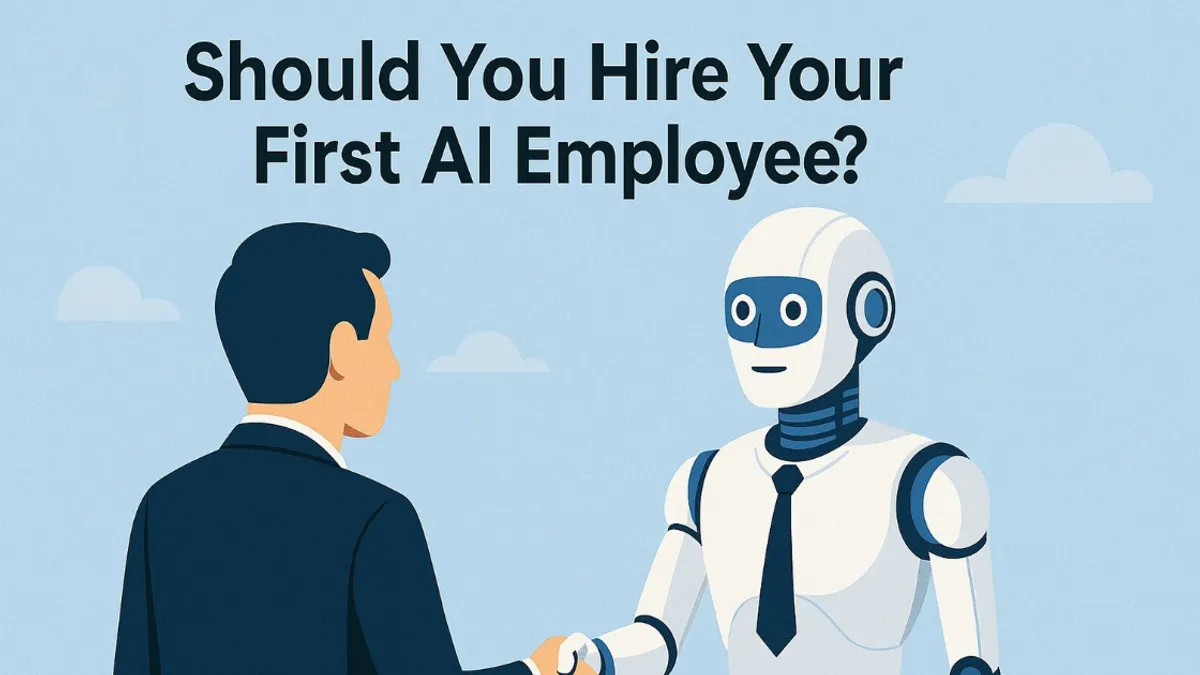Should You Hire Your First AI Employee in 2026?
Your operations director just told you it takes 12 hours of senior consultant time to configure each client deployment. You have 40 deployments this quarter.
That’s 480 hours—roughly $80,000 to $120,000—of senior consultant time on repeatable work.
An AI workforce could handle 70% of that. But what happens when it makes a mistake? How do you get your team to trust it? And which parts do you automate first?
The answer: Start with one high-frequency process, prove the ROI in 30 days, then scale systematically.
Here’s the truth: companies that figure this out in 2026 will have a massive advantage. Companies that wait will be playing catch-up for years.
Why Most Companies Haven’t Built Their AI Workforce Yet
The hesitation is rational:
Mixed Results: The internet is full of AI promises that don’t deliver in real-world professional services use cases.
Trust Issues: AI makes mistakes—though often less frequently than humans. But when an AI misconfigures a deployment, the accountability question is new territory.
Investment Risk: This isn’t just buying new software. Full AI workforce integration into a large professional services firm takes 12-24 months depending on firm size, process complexity, and change management capacity. That’s significant investment without guaranteed returns.
Employee Concerns: No manager wants to eliminate positions and replace people with AI.
But here’s what changes when you look at the cost of not starting.
The First-Mover Reality: Why Waiting Costs More Than Starting
Consider Both Sides of the ROI Equation
The Upside Potential:
- How much could your margins increase with 30-40% service delivery efficiency?
- How much could you grow without proportional headcount increases?
- How much better could your deliverables be with AI workforce handling documentation, reporting, and quality checks?
The Downside of Delay:
- Your competitors will move first and start outperforming
- Your company valuation suffers when investors see you lagging in technology adoption
- Your best talent gets frustrated spending time on work that feels repetitive and low-impact
Key Insight: You could wait for the next big AI model release to make everything easyier. The problem? Every other company gets the same release. Your competitive advantage comes from integration experience, not access to technology.
The Timeline Reality
For a large professional services firm, full AI workforce integration could take 12-24 months. This isn’t Microsoft Word 2.0—it’s a fundamental shift in operations, delivery, and even sales processes.
Companies starting now will have refined systems when your board finally mandates AI adoption in 2026.
So where do you actually start?
Your First 5 Steps to AI Workforce Integration
1. Audit Your Repeatable Processes (This Week)
- Review your last 20 client projects
- Identify tasks that appear in 15+ projects
- Focus on processes taking 3+ hours each time
- Example: client environment configurations, status report generation, data migration scripts
2. Ignore the “Too Complex” Objection (Seriously)
- Your team will argue their work is too nuanced for AI workforce automation
- That’s the opportunity—AI workforce handles complexity that traditional automation couldn’t
- Start with processes that have clear inputs/outputs and validation checkpoints
3. Pick ONE Process for a 30-Day Pilot
- Choose something with high frequency (weekly minimum)
- Ensure fast feedback loops
- Keep human review in place initially
- Measure time saved and error rates vs. human baseline
4. Build Confidence Before Scaling
- Run AI workforce and human outputs in parallel for 2-4 weeks
- Document where AI workforce excels and where it needs help
- Refine prompts, workflows, and review processes
- Get your team comfortable with AI-assisted delivery
5. Scale Systematically, Not Dramatically
- Add one new automated process per quarter
- Let your AI workforce grow alongside team confidence
- Track margin impact and client satisfaction metrics
- Reinvest savings into higher-value service offerings
30-Minute Action**: Open your project management system right now. Filter completed projects from last quarter. What task appears in every single one? That could be your starting point.
This approach consistently delivers measurable margin improvement across professional services firms of all sizes.
What Early Adopters Are Learning
Companies that have started integrating AI workforce are discovering clear patterns:
- Fastest ROI: Client reporting and documentation automation (4-6 weeks to positive return)
- Biggest surprise: Teams request more AI workforce assistance once they see quality results
- Common mistake: Starting too big instead of proving value with one process
This systematic approach is consistently delivering measurable margin improvement without the drama of failed enterprise rollouts.
The technology is ready. The question is whether you’ll lead or follow in your market. The firms that move now won’t just save costs—they’ll build the operational advantage that defines their competitive position for the next decade.
Start Your AI Workforce Journey This Quarter
Free AI Workforce Readiness Assessment
Find out which processes are ready for automation and what your realistic ROI looks like.
You’ll get:
- 3-5 highest-ROI automation targets for your firm
- Timeline and implementation roadmap based on your specific operations
- 30-day pilot plan with success metrics


